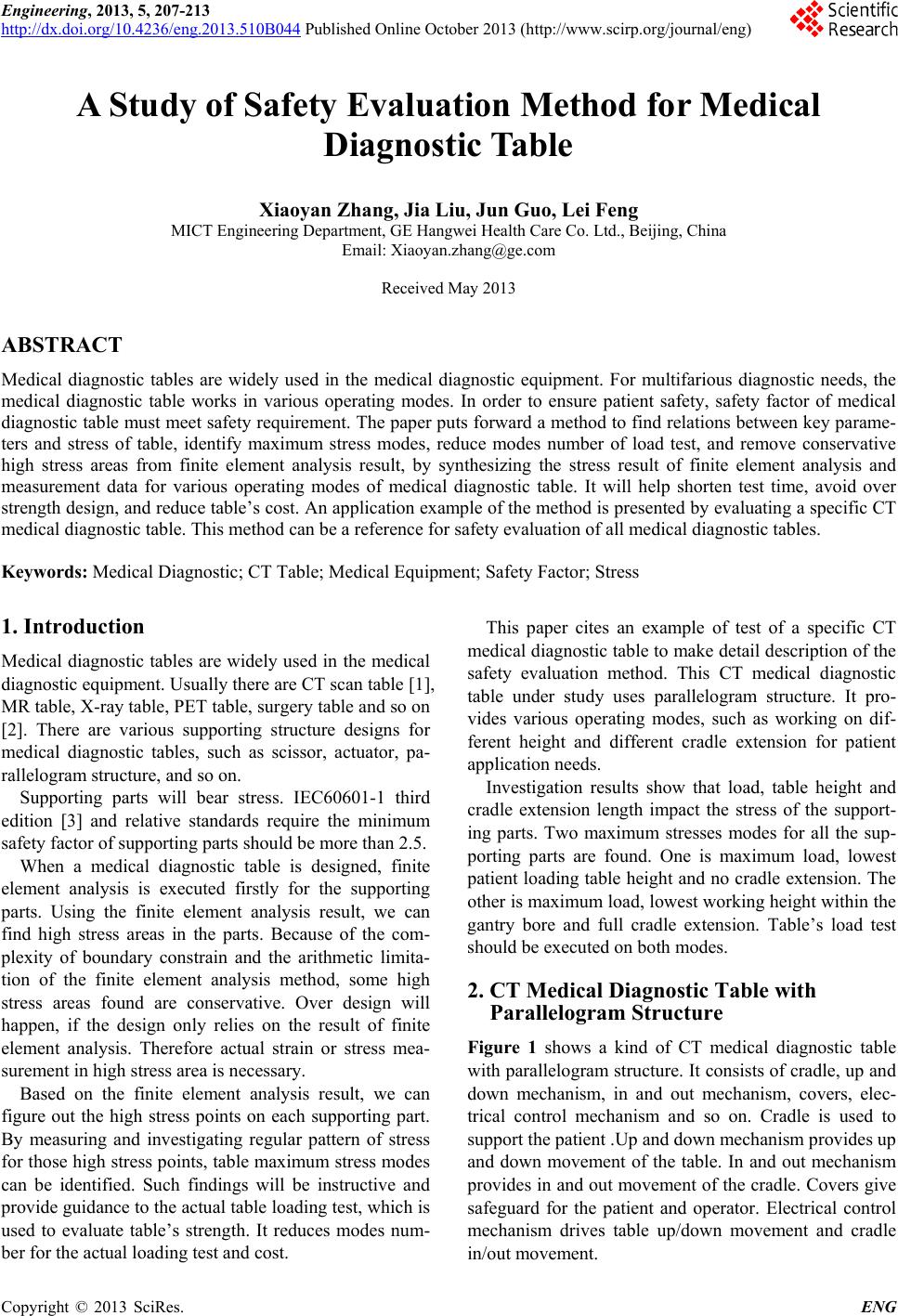
Engineering, 2013, 5, 207-213
http://dx.doi.org/10.4236/eng.2013.510B044 Published Online October 2013 (http://www.scirp.org/journal/eng)
Copyright © 2013 SciRes. ENG
A Study of Safety Evaluation Method for Medical
Diagnostic Table
Xiaoyan Zhang, Jia Liu, Jun Guo, Lei Feng
MICT Engineering Department, GE Hangwei Health Care Co. Ltd., Beijing, China
Email: Xiaoyan.zhang@ge.com
Received May 2013
ABSTRACT
Medical diagnostic tables are widely used in the medical diagnostic equipment. For multifarious diagnostic needs, the
medical diagnostic table works in various operating modes. In order to ensure patient safety, safety factor of medical
diagnostic table must meet safety requirement. The paper puts forw ard a method to find relations between key parame-
ters and stress of table, identify maximum stress modes, reduce modes number of load test, and remove conservative
high stress areas from finite element analysis result, by synthesizing the stress result of finite element analysis and
measurement data for various operating modes of medical diagnostic table. It will help shorten test time, avoid over
strength design, and reduce table’s cost. An application example of the method is presented by evaluating a specific CT
medical diagnostic table. This method can be a reference for safety evaluation of all medical diagnostic tables.
Keywords: Medical Diagnostic; CT Table; Medical Equipment; Safety Factor; Stress
1. Introduction
Medical diagnostic tables are widely used in the medical
diagnostic equipment. Usually there are CT scan table [1],
MR table, X-ray table, PET table, surgery table and so on
[2]. There are various supporting structure designs for
medical diagnostic tables, such as scissor, actuator, pa-
rallelogram structure, and so on.
Supporting parts will bear stress. IEC60601-1 third
edition [3] and relative standards require the minimum
safety factor of supporting parts should be m or e than 2. 5.
When a medical diagnostic table is designed, finite
element analysis is executed firstly for the supporting
parts. Using the finite element analysis result, we can
find high stress areas in the parts. Because of the com-
plexity of boundary constrain and the arithmetic limita-
tion of the finite element analysis method, some high
stress areas found are conservative. Over design will
happen, if the design only relies on the result of finite
element analysis. Therefore actual strain or stress mea-
surement in high stress area is necessary.
Based on the finite element analysis result, we can
figure out the high stress points on each supporting part.
By measuring and investigating regular pattern of stress
for those high stress points, table maximum stress modes
can be identified. Such findings will be instructive and
provide guidance to the actual table loading test, which is
used to evaluate table’s strength. It reduces modes num-
ber for the actual loading test and cost.
This paper cites an example of test of a specific CT
medical diagnostic table to make detail descrip tion of the
safety evaluation method. This CT medical diagnostic
table under study uses parallelogram structure. It pro-
vides various operating modes, such as working on dif-
ferent height and different cradle extension for patient
application needs.
Investigation results show that load, table height and
cradle extension length impact the stress of the support-
ing parts. Two maximum stresses modes for all the sup-
porting parts are found. One is maximum load, lowest
patient loading table height and no cradle extension. The
other is maximum load, lowest working height within the
gantry bore and full cradle extension. Table’s load test
should be e xe cuted on both modes.
2. CT Medical Diagnostic Table with
Parallelogram Structure
Figure 1 shows a kind of CT medical diagnostic table
with parallelogram stru cture. It consists of cradle, up and
down mechanism, in and out mechanism, covers, elec-
trical control mechanism and so on. Cradle is used to
support the patient .Up and down mechanism provides up
and down movement of the table. In and out mechanism
provides in and out movement of the cradle. Covers give
safeguard for the patient and operator. Electrical control
mechanism drives table up/down movement and cradle
in/out movement.